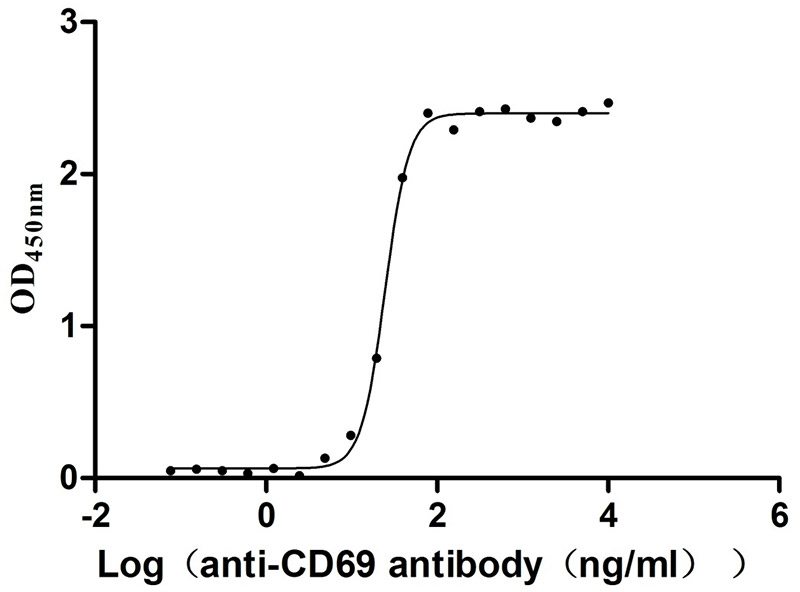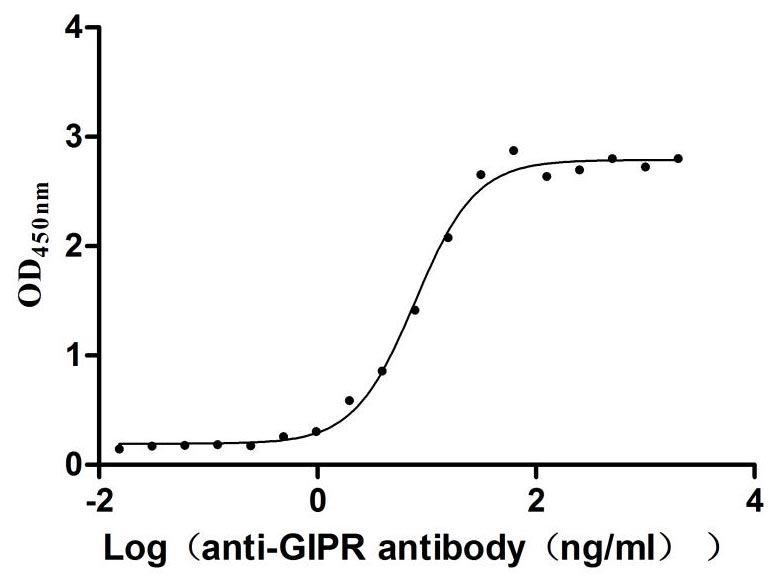Recombinant Human C-X-C motif chemokine 3 (CXCL3)
-
中文名稱:Recombinant Human C-X-C motif chemokine 3(CXCL3),Yeast
-
貨號(hào):CSB-YP006249HU
-
規(guī)格:
-
來源:Yeast
-
其他:
-
中文名稱:Recombinant Human C-X-C motif chemokine 3(CXCL3),Yeast
-
貨號(hào):CSB-EP006249HU-B
-
規(guī)格:
-
來源:E.coli
-
共軛:Avi-tag Biotinylated
E. coli biotin ligase (BirA) is highly specific in covalently attaching biotin to the 15 amino acid AviTag peptide. This recombinant protein was biotinylated in vivo by AviTag-BirA technology, which method is BriA catalyzes amide linkage between the biotin and the specific lysine of the AviTag.
-
其他:
-
中文名稱:Recombinant Human C-X-C motif chemokine 3(CXCL3),Yeast
-
貨號(hào):CSB-BP006249HU
-
規(guī)格:
-
來源:Baculovirus
-
其他:
-
中文名稱:Recombinant Human C-X-C motif chemokine 3(CXCL3),Yeast
-
貨號(hào):CSB-MP006249HU
-
規(guī)格:
-
來源:Mammalian cell
-
其他:
產(chǎn)品詳情
-
純度:>85% (SDS-PAGE)
-
基因名:
-
Uniprot No.:
-
別名:C-X-C motif chemokine 3; C-X-C motif chemokine ligand 3; Chemokine (C X C motif) ligand 3; Chemokine (CXC motif) ligand 3; Cinc 2; CINC 2b; Cinc2; CINC2b; CXCL 3; Cxcl3; CXCL3_HUMAN; Cytokine induced neutrophil chemoattractant 2; Dcip1; Dendritic cell inflammatory protein 1; Gm1960; GRO protein gamma; GRO-gamma; GRO-gamma(1-73); GRO-gamma(5-73); GRO3; GRO3 oncogene; GROG; Growth regulated protein gamma; Growth-regulated protein gamma; Macrophage inflammatory protein 2 beta precursor ; Macrophage inflammatory protein 2-beta; Melanoma growth stimulatory activity gamma; Member 3; MGSA gamma; MIP 2b; MIP2-beta; MIP2B; SCYB3; Small inducible cytokine subfamily B
-
種屬:Homo sapiens (Human)
-
蛋白長(zhǎng)度:Full Length of Mature Protein
-
表達(dá)區(qū)域:35-107
-
氨基酸序列ASVVTE LRCQCLQTLQ GIHLKNIQSV NVRSPGPHCA QTEVIATLKN GKKACLNPAS PMVQKIIEKI LNKGSTN
-
蛋白標(biāo)簽:Tag?type?will?be?determined?during?the?manufacturing?process.
The tag type will be determined during production process. If you have specified tag type, please tell us and we will develop the specified tag preferentially. -
產(chǎn)品提供形式:Lyophilized powder
Note: We will preferentially ship the format that we have in stock, however, if you have any special requirement for the format, please remark your requirement when placing the order, we will prepare according to your demand. -
復(fù)溶:We recommend that this vial be briefly centrifuged prior to opening to bring the contents to the bottom. Please reconstitute protein in deionized sterile water to a concentration of 0.1-1.0 mg/mL.We recommend to add 5-50% of glycerol (final concentration) and aliquot for long-term storage at -20℃/-80℃. Our default final concentration of glycerol is 50%. Customers could use it as reference.
-
儲(chǔ)存條件:Store at -20°C/-80°C upon receipt, aliquoting is necessary for mutiple use. Avoid repeated freeze-thaw cycles.
-
保質(zhì)期:The shelf life is related to many factors, storage state, buffer ingredients, storage temperature and the stability of the protein itself.
Generally, the shelf life of liquid form is 6 months at -20°C/-80°C. The shelf life of lyophilized form is 12 months at -20°C/-80°C. -
貨期:Delivery time may differ from different purchasing way or location, please kindly consult your local distributors for specific delivery time.Note: All of our proteins are default shipped with normal blue ice packs, if you request to ship with dry ice, please communicate with us in advance and extra fees will be charged.
-
注意事項(xiàng):Repeated freezing and thawing is not recommended. Store working aliquots at 4°C for up to one week.
-
Datasheet :Please contact us to get it.
相關(guān)產(chǎn)品
靶點(diǎn)詳情
-
功能:Ligand for CXCR2. Has chemotactic activity for neutrophils. May play a role in inflammation and exert its effects on endothelial cells in an autocrine fashion. In vitro, the processed form GRO-gamma(5-73) shows a fivefold higher chemotactic activity for neutrophilic granulocytes.
-
基因功能參考文獻(xiàn):
- CXCL3 exerts its carcinogenic potential by directly and/or indirectly regulating the downstream signaling pathways and the expression of transcription factors in PCa. PMID: 29524043
- Exogenous CXCL3 induced Erk1/2 and ETS1 phosphorylation and promoted CD133 expression. PMID: 27255419
- Our findings suggest that CXCL3 and its receptor CXCR2 are overexpressed in prostate cancer cells, prostate epithelial cells and prostate cancer tissues, which may play multiple roles in prostate cancer progression and metastasis. PMID: 26837773
- results support a functional role of CXCL3 in breast cancer metastasis and as a viable target for cancer therapy PMID: 24605943
- CXCL3 displays antimicrobial activity against E. coli and S. aureus. PMID: 12949249
- secreted growth-regulated oncogene chemokines, specifically GRO-gamma, in human Mesenchymal stromal cell-conditioned media have an effect on the differentiation and the function of human monocyte-derived dendritic cells. PMID: 23589610
- Data show that mesenchymal stem cells (MSCs) directly regulate T cell proliferation by induction of CXCL3 chemokine and its receptor, CXCR2 on the surface in T cells. PMID: 23023221
- demonstrates, for the first time, that BIRC3 (anti-apoptotic protein), COL3A1 (matrix protein synthesis), and CXCL3 (chemokine) were up-regulated in the thrombin-stimulated human umbilical vein endothelial cells PMID: 16356540
- GRO-gamma is a promising candidate for Th2-associated glomerular permeability factor in minimal change disease. PMID: 17389786
- Inhibition of ERK phosphorylation decreased expression of GRO3. PMID: 17466952
- Report gonadotropin-releasing hormone-regulated CXCL3 expression in human placentation. PMID: 19369450
- propose that chemokines belonging to the CXC family could play an important role in the etiology of tendon xanthoma (TX), with CXCL3 being a possible biological marker of onset and development of TX PMID: 19448742
- overexpression of CXCL13 in the intestine during inflammatory conditions favors mobilization of B cells and of LTi and NK cells with immunomodulatory and reparative functions. PMID: 19741597
顯示更多
收起更多
-
亞細(xì)胞定位:Secreted.
-
蛋白家族:Intercrine alpha (chemokine CxC) family
-
數(shù)據(jù)庫(kù)鏈接:
Most popular with customers
-
Recombinant Human HLA class II histocompatibility antigen gamma chain (CD74), partial (Active)
Express system: Mammalian cell
Species: Homo sapiens (Human)
-
Recombinant Human Melanoma-associated antigen 4 (MAGEA4) (Active)
Express system: Mammalian cell
Species: Homo sapiens (Human)
-
Recombinant Human Somatostatin receptor type 2 (SSTR2)-VLPs (Active)
Express system: Mammalian cell
Species: Homo sapiens (Human)
-
Recombinant Human C-C chemokine receptor type 8 (CCR8)-VLPs (Active)
Express system: Mammalian cell
Species: Homo sapiens (Human)
-
Recombinant Human Tumor-associated calcium signal transducer 2 (TACSTD2), partial (Active)
Express system: Mammalian cell
Species: Homo sapiens (Human)
-
Recombinant Human Early activation antigen CD69 (CD69), partial (Active)
Express system: Mammalian cell
Species: Homo sapiens (Human)
-
Recombinant Human Myosin regulatory light polypeptide 9 (MYL9) (Active)
Express system: Yeast
Species: Homo sapiens (Human)
-
Recombinant Rat Gastric inhibitory polypeptide receptor (Gipr), partial (Active)
Express system: Mammalian cell
Species: Rattus norvegicus (Rat)


-AC1.jpg)

















